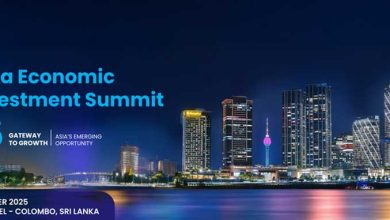LMDtv 4
US President Donald Trump appears to be opening the door to a new world order – one where tariffs and taxes will determine bilateral and multilateral trading relationships, and the future of world trade.
“The situation is very fluid and developing,” commented Group Finance Director of MAS Capital Surath Chandrasena during an LMDtv interview conducted at the end of March, only days before Trump stunned the world with his wide ranging tariffs.
He explained that it’s possible to consider various scenarios that may play out, albeit with uncertainty, anxiety and further changes in the pipeline.
Chandrasena elaborated on the first and worst scenario: “There will be trade wars between countries and regions where everybody will retaliate and raise tariffs. You’ll see regional trade blocs emerging and world trade losing ground. It can have an impact on economies because with higher tariffs and less trade, inflation will rise, consumers will spend less and volumes will fall.”
Chandrasena added: “The opposite could also happen, and you could see countries coming to the negotiation table and lowering their tariffs.” The US will be looking at developing trading relationships on terms more favourable to it; and in such an instance, there could be collaboration and tariffs being reduced.
He continued: “In reality, we could also fall somewhere between countries that choose to retaliate and those that prefer to cooperate with the US.” He added that in such a scenario, we may see the advent of trade blocs or the world will be divided into different trading unions where countries will trade with each other.
The impact on Sri Lanka is still too early to determine. He noted: “The impact on Sri Lanka really depends on which industries will be affected and how we can partner successfully with other nations.”
As he noted, “one opportunity that comes with the possibility of a trade war is that industries and sectors will want to mitigate sourcing risks. So if they were only sourcing from one particular region previously, they may diversify their sourcing base to include a range of countries from different continents.”
Yet, the threats from tariffs may increase and the 44 percent tariff imposed on all goods from Sri Lanka, which was announced on 2 April, will certainly challenge the economy.
“The challenge will be the threat of a recession, and possibly reduced consumer demand due to higher tariffs and inflation,” he warned, and added that in export markets such as the US and EU, tariffs might impact inflation and see consumers spending less. This may lead to a lower demand for goods and that will hurt Sri Lanka.
Chandrasena also pointed out that “the US is Sri Lanka’s largest export market and accounts for about a quarter of our exports. So a recession or high inflation in the US and consumers curtailing demand will impact us adversely. There can also be pricing pressure facing Sri Lankan exporters.”
He explained: “When the economy slows down as tariffs hit, foreign importers will be looking at their sourcing partners or supply chains to cut costs to maintain or curtail price increases for their consumers. So there can be pressure on margins and pricing.”
“Therefore, while there may be volume upside, we may see increased pressure on margins to share some of the burden of the additional tariffs,” he added.
Sri Lanka’s recent tax proposals seem to offer some hope but the devil is in the implementation details.
He stated: “We saw many proposals in the budget to support exporters and improve the ease of doing business, through concepts such as the National Single Window (NSW) and a one stop shop Custom law. While there have been many different proposals submitted in national budgets, most often there’s been no implementation… or it has been very slow.”
“The expectation is that if we can implement these proposals, it will really help the ease of doing business and support our community of exporters,” Chandrasena concluded.




